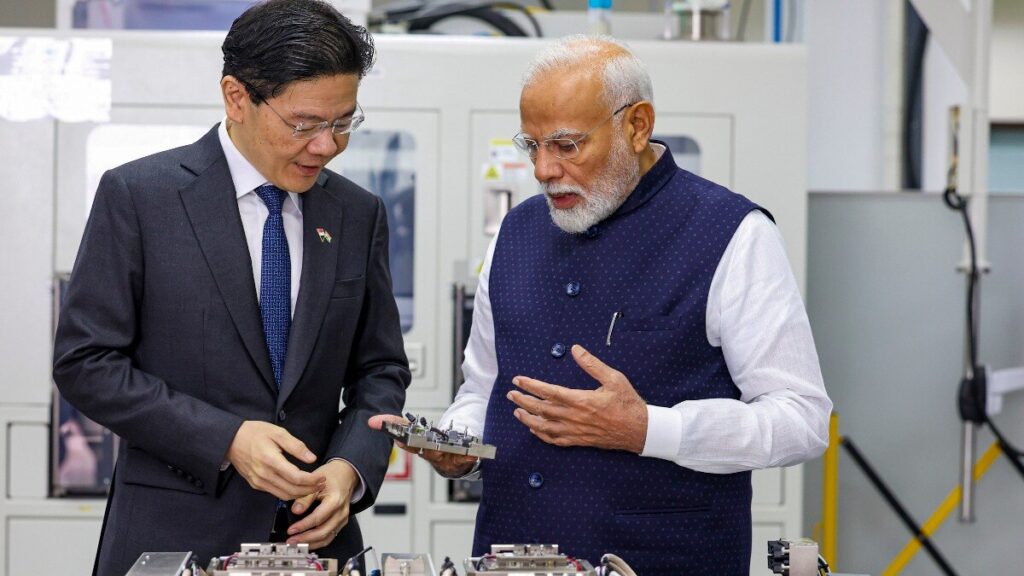Prime Minister Narendra Modi is on a two-day visit to Singapore. On the second day of the visit, PM Modi met with Singapore Prime Minister Lawrence Wong. During this, four important agreements were also signed between India and Singapore.
On the second day of his visit, PM Modi along with Lawrence Wong also visited the semiconductor center of Singapore’s AEM Holdings Limited. PM Modi invited companies to attend the Semicon India Exhibition. Semicon India Exhibition will be held in Greater Noida from 11 to 13 September.
After this, Prime Minister Modi said that he wants to create many Singapores in India too. PM Modi said, ‘We want to create many Singapores in India too and we are happy that we are working together in this direction.’
But why did Prime Minister Modi say this? Actually, the reason behind saying this is to make India a big hub of semiconductor industry like Singapore.
What does Singapore mean?
Singapore is spread over an area of 735 square kilometers, made up of more than 60 small islands. If seen, Singapore is about four and a half thousand times smaller than India. But despite being so small, Singapore is the king of the semiconductor industry.
The semiconductor industry accounts for 7% of Singapore’s GDP. Singapore holds 10% of the world’s semiconductor market. At the same time, Singapore’s share in manufacturing semiconductor-related equipment is 20%. Not only this, 5% of the world’s semiconductor industrial parks are also in Singapore.
According to the report, 9 out of the 15 top semiconductor companies in the world have opened their branches in Singapore.
There are four major players in the semiconductor industry. First- IC design. Second- assembly, packaging and testing. Third- wafer fabrication or industrial park. Fourth- equipment production. Singapore dominates all four of these.
According to data from the Singapore government, the semiconductor industry in the country grew at an annual rate of 9.3 percent between 2000 and 2022. Singapore’s manufacturing sector is completely dependent on semiconductors. The semiconductor industry has a 44% share in the manufacturing sector.
But how did all this happen?
In the 1960s, American chip companies turned to Singapore and South Asian countries. The reason for this was that good labour was available here at a cheap rate. Singapore took advantage of this. Singapore’s economy has always been dependent on the manufacturing sector. Therefore, those working in the manufacturing sector also get good salaries.
According to the Singapore Economic Development Board (EDB), Singapore has invested a lot in the last 55 years to make itself the biggest hub of the semiconductor industry. Such infrastructure has been developed here for the semiconductor industry. Microelectronics and IC designing are taught in Singapore’s colleges and universities so that the youth can be prepared for it.
Not only this, the government of Singapore also spends a lot on research and development. 28 billion dollars will be spent on this in the next five years.
Can Singapore be created in India?
What Prime Minister Modi said meant that like Singapore, India can also become a big hub of semiconductor industry. Increasing technology has also increased the semiconductor industry.
By 2023, the worldwide semiconductor market was worth $600 billion. It is expected to cross $680 billion by this year. Whereas, by 2032, the semiconductor market is estimated to exceed two thousand billion dollars.
The chips currently made in Singapore are not very advanced. The chips made there are used in appliances, cars and equipment. But the way Artificial Intelligence (AI) is growing, it requires more advanced chips, which are not made in Singapore. In such a situation, India has an opportunity to persuade semiconductor companies to set up manufacturing plants here.
Now most companies are investing heavily in AI chips. The good thing for India is that most of the companies which have plants in Singapore are not interested in investing there for AI chips. Companies like TMC, Samsung and Intel are looking for places outside Singapore.
India’s semiconductor market is growing continuously. By 2023, India’s semiconductor market was worth $35 billion. It is expected to grow to $190 billion by 2023. Many top companies of the world have already set up manufacturing plants in India. Many Singapores can be created in India because it not only has resources but also a young population.
Source (PTI) (NDTV) (HINDUSTANTIMES)
